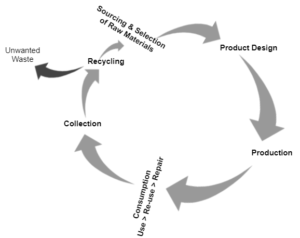Sustainability is not a new concept, it has been in existence for decades; but the concept became more popular after a series of global catastrophes – such as the use of chemical bombs in world wars, the Great Depression, collapse of corporations due to mismanagement as seen in the global financial crisis, inhumane working conditions as witnessed in the fashion industry, extinction of endangered species, destruction of forests due to upsurge in urbanisation, etc. In present days, the emergence of COVID-19 has revealed to the world that current generations must act responsibly to ensure that the human race and the earth it inhabits are preserved.
Generally, the concept of sustainability involves the use of available resources to cater for needs of the current generation while ensuring that the same resources will be available to meet the needs of future generations. In its broad context, sustainability has three pillars: namely financial or business; social; and environment. Using the sustainable development matrix as a guide, the financial pillar has to do with responsible business by corporations and their relations with stakeholders, while the social pillar tackles the creation of value for society. The environmental pillar concerns itself with responsibly managing natural resources in a way that is beneficial to everyone.

Figure 1.0: Sustainable Development Matrix
One issue that has continuously been of keen interest to world leaders, business leaders and captains of industry is climate change. Climate change involves rampant and continuous transformation of the world’s climate pattern leading to harsh conditions as the result of an increase in carbon dioxide and other greenhouse gases in the atmosphere. Interestingly, emissions of greenhouse gases are largely caused by human activities.
Data from Oxford University show that emissions of carbon dioxide have grown over time due to several reasons, with the most dominant being arrival of the industrial revolution. For instance, based on OECD data, in 2020 Asia Pacific, North America, Europe, Middle East and Africa emitted 16.75 billion metric tonnes, 5.3 billion metric tonnes, 3.59 billion metric tonnes, 2 billion metric tonnes and 1.19 billion metric tonnes of carbon dioxide respectively. Emissions from aforementioned continents were relatively lower decades ago.
Although the industrial revolution benefitted humanity, it also witnessed an upsurge in usage of unsustainable energy sources such as coal and fossil fuels, while petrol and diesel were widely used to produce energy for manufacturing plants, heating, lighting, etc. This phenomenon resulted in a gradual rise of global temperature, leading to changes in weather patterns and bringing out negative effects such as wildfires and hurricanes, droughts and heat-waves, and rising sea levels.
In 2015, world leaders took action by signing an international treaty now known as the Paris Agreement to guide countries on mitigation, adaptation and financing measures required to combat climate change. Following from this, efforts were made globally to curb climate change through building sustainable ecosystems and decreasing the carbon footprint of industries. This resulted in new strategies with terminologies such as ‘net zero’, energy transition and decarbonisation dominating discourses.
The realignment of supply chains as a result of achieving net zero has affected almost all industries, including the transportation sector – which is one of the key sectors that contributes high carbon dioxide emissions globally, leading to disruptive innovation in the transportation sector. The transportation sector has therefore been bombarded with new innovations that are intended to make the world a better place for both current and future generations through development and subsequent manufacturing of alternative vehicles which emit less carbon dioxide, such as electric vehicles.

Genepax, a Japanese company claims its automobile is powered by water with a system similar to a fuel cell.
The world has gotten to a tipping point – where to improve energy security, primary energy sources such as coal, fossil fuel and nuclear energy must be diversified or replaced with clean, safe, reliable and available energy sources such as solar energy, wind energy, water or hydro energy, geothermal energy, bioenergy energy, and hydrogen and fuel cells. These alternative energy sources have also been in existence for decades, likewise the technologies used to harness them have been available for years; but now they are significant due to the current commercialisation potentials.
Although diversifying primary energy sources looks like a daunting task, its positive impact is enormous. For instance, replacing unsustainable energy supplies with cleaner options brings about supply chain innovations. These innovations lead to improved efficiency; reduced risk; reduced long-term expense; job creation; supplier and client retention; improved culture and enhanced reputation.
The continuous increase in demand for products globally as a result of population growth, globalisation, etc., has made green supply chain management more prominent these days. It is now essential to ensure that designing, sourcing and choosing materials, producing and distributing products and services to consumers and managing end of life usage of these products are done in a sustainable way. However, integrating environmental philosophy into supply chain management might be a complex undertaking for most industries.
Using the automobile industry as a case study, adopting the circular economy – which emphasises recycling and reusing materials from finished products over a long period of time – would ensure that resources are used efficiently; thereby reducing waste and achieving higher sustainability ratings. However, automobiles generally have over 30,000 parts, which makes it extremely difficult to make the supply chain entirely sustainable.

Figure 2.0: Overview of circular economy
The introduction of alternative fuel vehicles – of which electric vehicles are topical currently, unfortunately does not also solve the larger environmental issues. This is because sustainably disposing of electric vehicle components such as batteries is a challenge. Beyond that, to achieve 100% supply chain sustainability, it must be ensured that input resources and transformation processes of an operation are acquired and undertaken sustainably; thus raw materials, product designs, production, end-user usage and waste disposal must be deeply rooted in the concept of sustainability.
Irrespective of the hurdles, alternative fuel vehicles drastically help to reduce tailpipe emissions; which is vital in curbing climate change. Europe, North America and Asia have all made huge progress with alternative fuel vehicles in terms of market penetration and consumer adoption, in comparation to Africa.
In the quest to decarbonise the world through reducing carbon dioxide emissions in heavy emitting sectors such as the global transportation sector and achieve net zero, mass producing electric vehicles is significant because of the purchase price and monthly running cost – which have been identified as factors preventing adoption of electric vehicles in developing countries.
Africa is vital to reducing emissions in the transportation sector because of the continent’s demographics and socio-economic factors which are relevant in today’s world. This is because Africa is home to an over-one-billion-population, of which half is youthful. Africa’s middle class has increased steadily for the past three decades. With the introduction of a continental free trade agreement in Africa, it is expected that industries will grow; leading to the rise of a large middle class population.
This phenomenon is expected to result in increased disposable income for the middle class; and with road transportation being a major form of mobility in Africa especially for the middle class, conventional vehicle (powered with fossil fuels) sales are expected to increase in the future; expectedly up to 10 million cars per year by 2025. The rise of road vehicles in the world’s second-most populous continent will present both threats and opportunities in the global quest to achieve net zero. Mass production of less tail-pipe carbon dioxide-emitting vehicles is therefore one of the utmost ways to ensure that as the African market and middle class grows, the transportation industry in Africa becomes more environmentally sustainable and thereby helps the world to curb climate change.










